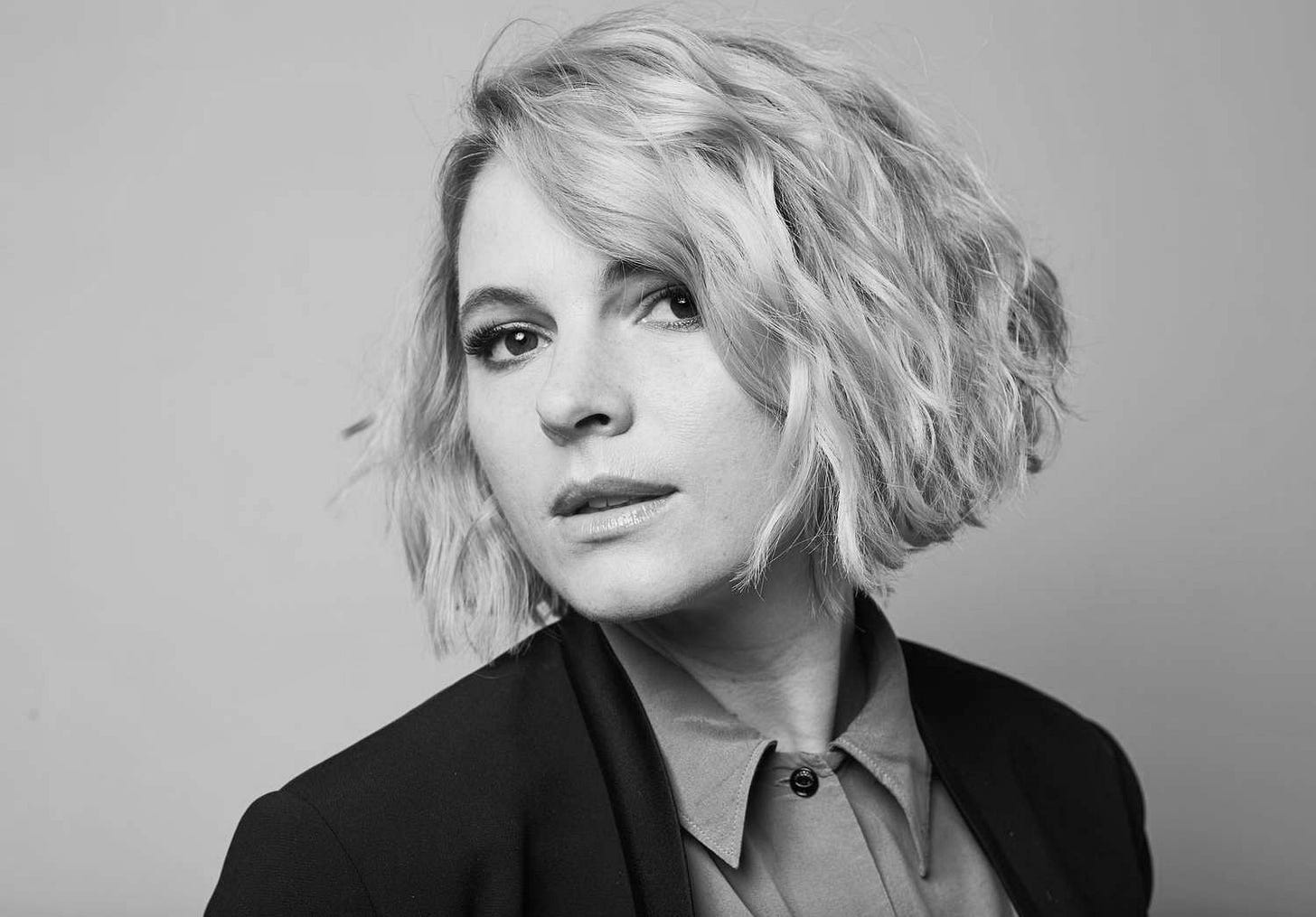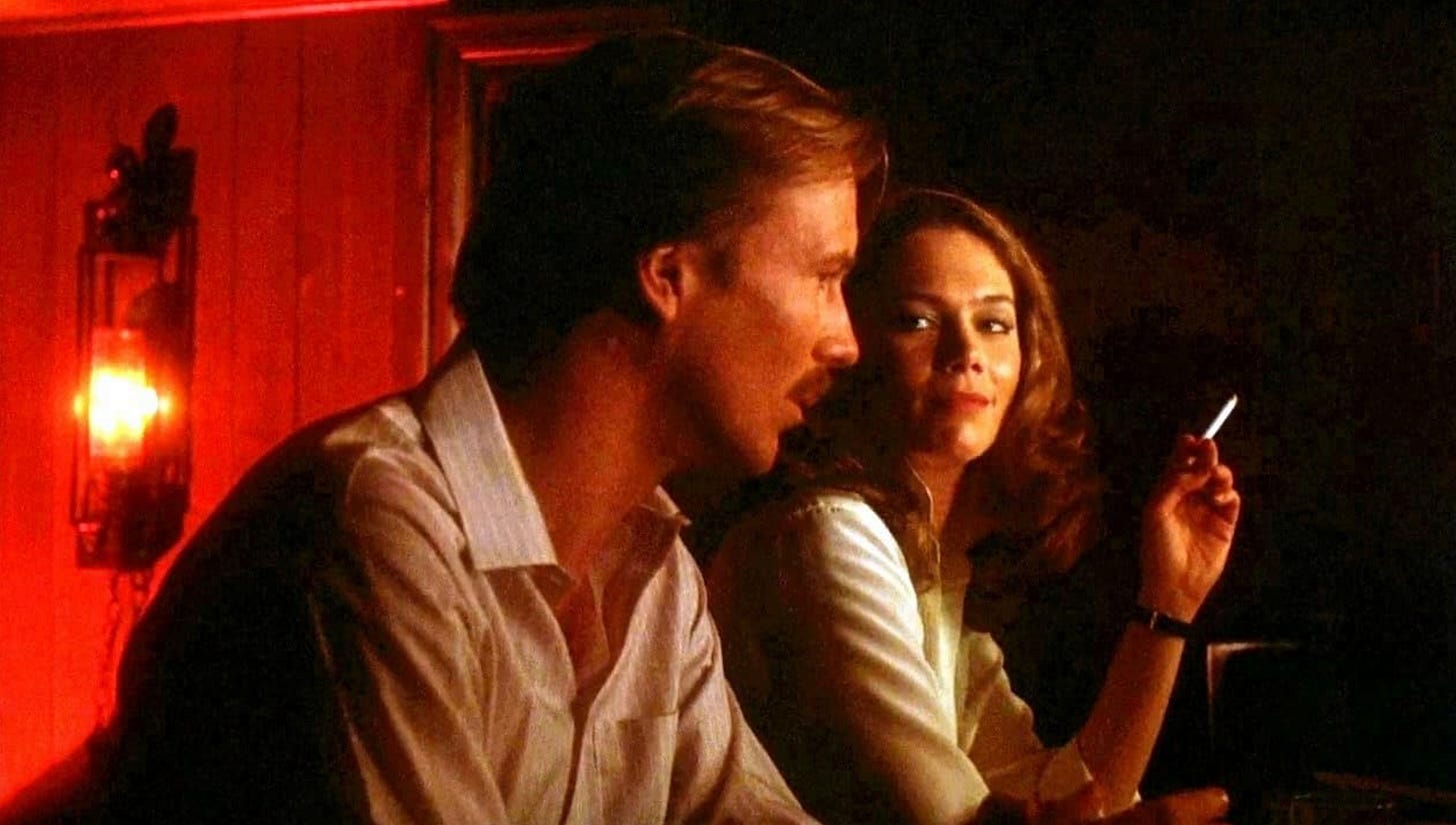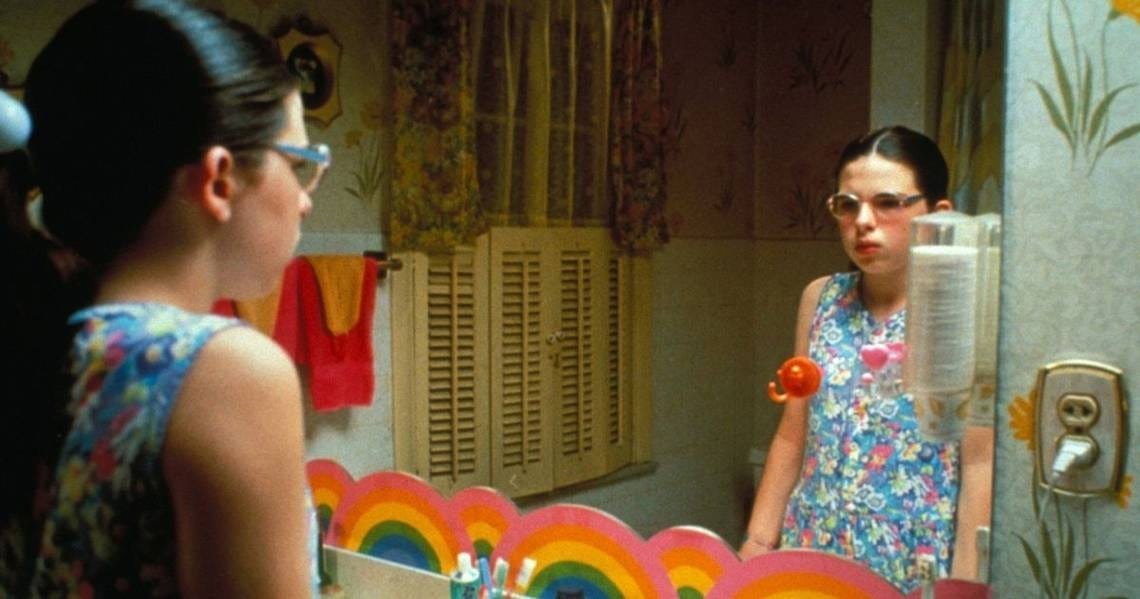Q&A: Filmmaker Amy Seimetz Is an Enigma in an Enigmatic World
In a far-reaching conversation about...like...everything, the screenwriter, director, and actress helps me try to work out who she is an artist
Amy Seimetz is an enigma, and I think that’s what I loved most about my conversation with her. The director, screenwriter, and actress doesn’t have all the answers, she’s as conflicted about the intersection of art and commerce and the future of her industry as most of us are, and yet she strikes me as determined to keep working at finding out what the answers are — at least with regard to her life as a storyteller. I mean, how do you peg down an artist as comfortable being in flux — or “fluid”, her word — as she is?
The two of us found our way to each other through her friend writer-director Susanna Fogel, who joined me for one of my artist-on-artist conversations back in 2023. It didn’t take a lot more than mentioning her name to get me to say yes to a chat with the co-creator/showrunner of the brilliant TV series “The Girlfriend Experience” (2016) — though my love affair with Amy’s work began a bit earlier, in 2012 to be exact, with her film Sun Don’t Shine. Written, directed, produced, and co-edited by her, it won a Special Jury Award at SXSW that year. Her most recent feature film as director was She Dies Tomorrow (2020), which is wonderfully bonkers and intellectually thrilling in a way I wish more films were. As an actress, she’s appeared in countless indie and Hollywood films and TV series such as Tiny Furniture and The Myth of the American Sleepover (both 2010), “The Killing” (2013), “Halt and Catch Fire” (2016), Alien Covenant (2017), Pet Sematary (2020), and No Sudden Move and “Sweet Tooth” (both 2021). I have no doubt you’ve seen her work both in front of and behind the camera; she’s eminently watchable, prone to distinct, unexpected decisions — and the same can be said about her direction in both film and TV.
As Amy and I chatted — a conversation that had a few starts and stops over 2024, culminating in the middle of a Floridian hurricane — we dove into questions not so much about her craft as the life experiences that forged the complicated, sometimes self-contradictory, always thought-provoking artist that she is. I was constantly challenged, stimulated, and thrilled by what she had to say. I think honest, raw, and brilliant are all words I could use to describe her answers to my questions. Now, before I throw even more adverbs and adjectives at her, I’m going to just dive in. I hope you enjoy this artist-on-artist conversation as much as I did!
COLE HADDON: Let’s start with a fun question, or at least I think it is. Tell me about a film or television series you love that no one else agrees with you about. But I don’t just want a name. I want to know what you see that others don’t and maybe even why you think that is.
AMY SEIMETZ: I mostly find it’s the opposite - that I get spun into wondering why I make films when I see something everyone else loves or likes and I don’t understand. It’s hard to think of one, mostly because the internet is filled with opinions that agree or disagree with my likes and dislikes. I do remember in my teens and early twenties insisting Glenn Close was the hero of Fatal Attraction - as was Sharon Stone in Basic Instinct and Demi Moore in Disclosure. Perhaps we could assume I had it out for Michael Douglas, but I also found the struggle of Rebecca De Mornay in The Hand That Rocks the Cradle worthy of its own spin-off/sequel. This is related to entire 24-four-hour periods of me watching Lifetime programming or loving horror or “General Hospital” and “All My Children” and Jerry Springer and Phil Donahue - all introduced to me by my Grandma Jayne, who was an ER nurse who smoked inside and taught me Gin Rummy. I have a soft spot for anything histrionic. Which is odd ’cause as an actor, I am always trying to be as subtle as possible.
CH: Good god, there’s so much to unpack here! Let’s skip the part where you just made me miss my grandmother – who taught me how to play Gin Rummy, too – and dig into the fact that you spent a huge chunk of some of your most formative years identifying femme fatales as the heroes of their stories. Why do you think that is?
AS: Good question. There’s the obvious - they are women. So instantly, I assume the little me was attaching to their stories as examples of what to become or what not to become as a grown woman. In addition, the women who raised me were very much in control of their own livelihoods. Both grandmothers had their own careers – Grandma Jayne was an ER nurse, my grandma Shirley decided at 42 to go to college and ended up getting her master’s in teaching, my mother had her master’s degree and a full career as a speech pathologist. Without digging too deep into familial dysfunction, the patriarchal nuclear family ideal was a bust.
CH: The women in your family sound amazing.
AS: They were very open about it all – crass and brash even – about navigating work and men and children and sexuality and their bodies. Funny and dark and complicated…and a little wicked at times.
I am psychoanalyzing myself here, so this might be a stretch, but the femme fatales are active characters. Deceptive and devious sure, but actively plotting their way out of shitty situations. Albeit a problematic construct – the psychotic woman – those female characters were smart and forces to be reckoned with, equals to the male counterparts on-screen. Let’s not forget those roles were played by wildly interesting and talented women themselves.
CH: Absolutely.
AS: I just rewatched Body Heat and forgot how well-directed/acted it was - and playful. I think it’s interesting territory, but also dangerous. I don’t want to promote the idea that women are hellbent on revenge, ’cause that is a narcissistic fantasy - that we eat, breathe, and sleep ruining the lives of men. In fact, that’s also why I find those movies so entertaining - they feel like dark comedies. Clearly, [Paul] Verhoeven understood the comedy of it. And upon my rewatch, [Lawrence] Kasdan did, too.
CH: Let’s dig into your back story a bit more. Was it always the moving image for you?
AS: I wanted to be a doctor.
CH: Really?
AS: An orthopedic surgeon. I liked the carving and correcting of bones and tissue and joint replacements. Maybe it was a sculptural drawing, or maybe because my grandma talked about the grotesque things she saw in the ER. My mom’s job was all about helping people learn or relearn how to put thought into words, whether that was due to head injuries from accidents or strokes or a speech impediment the developed as a child – so she was always looking at people’s non-verbal cues or finding ways to help them to speak. I also had a stutter when I was little, so I think the nonverbal element of film and expression has been interesting to me. Or maybe the struggle to find words is interesting to me.
CH: What about your father?
AS: My dad sold houses here in Florida. So, I would go with him to look at houses a lot – some empty, some with people’s furniture and family photos and messes – each space telling a different story no matter what state it was in. Holes in walls, or painted, or remodeled, or left with original flooring and architecture. It all told something about the person living there, about the time we lived in, or what the person was going through. My dad – he passed in 2012 – he told me a sale of a home is like a pivot in someone’s life. They are starting a family, starting adulthood, starting a new phase and reversely getting a divorce, coming upon hard times or ending a phase.
CH: From your grandmother’s morbid oversharing, to your mother’s role of helping give voice to others, to your father’s rather existential approach to being a realtor must’ve provided your creative imagination a lot of fascinating fuel. When did it become obvious to you that you had a storyteller’s heart?
AS: I didn’t really think I would make a living writing or making film/TV. That’s a long tangent I can go on. The idea of it still feels very mercurial. But Welcome to the Dollhouse was the first film I saw that clicked. I just hadn’t seen the strange people I grew up with represented. And that movie hit a tone that made me realize it was okay to explore my own oddness. I didn’t grow up around art, so that kicked off my search for more film like it.
CH: So, you would’ve only been what, 14-years-old when Welcome to the Dollhouse came out? I had one of these conversations with
about, in part, independent cinema in the ’90s. He helped to run Good Machine at the time, if you’re unfamiliar with his history, but he was at ground zero for all of it. I find this period a special kind of great existential torture as an artist. I’m immensely grateful for it and the stories and filmmakers it produced – what it all meant to me and the world – but I, you, so many others came of age in it and now must contend with a marketplace that seems largely disinterested in those kinds of stories. Does that resonate with you at all? You’ve had more than your share of independent cinema experiences at this point, including producing some indie features, but we just feel like we’re constantly moving further away from that golden age and, nearly a quarter-century on, no similar revolutions even seem like they could be around the corner.AS: Hm. I have lots of questions before I can speak specifically to that. So curious what he thinks given his breadth of experience from independent producing to studio exec. Curious about his take on whether the marketplace was interested in those stories then or if they carved out a space and then the marketplace followed. There’s also the question of what’s considered a success. There are obvious markers – like box office and awards – but then there are movies that influence pop culture and the way we tell stories that may not have been “hits”. Also – currently in a post-strike world colliding with AI – who the fuck knows?
CH: Fair.
AS: I was in college – or right out of college – when the digital cameras that were coming out made filmmaking more accessible/less expensive yet competitive with 16mm/35mm. So, myself, Barry Jenkins, Adele Romanski, David Robert Mitchell, Justin Barber, Wes Ball, Lauren Miller – only naming FSU alum there at same time as me – jumped on that with excitement. At the same time, the editing programs and computer processing and speed of hard drives allowed Nat Sanders and Joi McMillon and Greg O’Bryant and Julio Perez to edit our micro-budget movies on computers at home. And once our films started going to festivals, we met other people who had made movies because the tech made everything more accessible and less of a pipe dream. And then that circle widened and widened…
I try not to get too nostalgic - doesn’t mean I don’t get nostalgic. I think what’s special about those convergences of ideas and technology and then a marketplace that recognizes it is that it will never be again. There will be new convergences and certainly things lost…is that the existential torture you are talking about? Are we talking equitable art or making art? They hold different spaces for me. What’s Ted say?
CH: Ted is much more optimistic than I am, but I suspect a part of that is due to his personality. He came from a very punk aesthetic background, as did so much of the ’90s movement. Revolution was hardwired into the mindset. As much as we were seeing filmmakers raised on ’70s cinema getting their hands on cameras and equipment for the first time, those filmmakers – and indie producers – were far more predisposed to DIY and innovation within the market – or so that is his argument. I think I agree.
Most of today’s filmmakers and producers don’t have the same cultural DNA, which is where my worry comes in. With streamers dominating distribution and screens not available the way they were in the ’90s to support indie film, or frankly an audience that grew up on ’70s film and expected a certain kind of auteur aesthetic, I just don’t see how that revolution happens now in any way that could even approach what happened a quarter-century ago. Ted is, again, far more hopeful and thinks it’s a building problem. You have to reimagine the marketplace.
AS: It’s all branding, no?
CH: How so?
AS: Like, at this point, even being punk or deviant or subversive is a brand - and then it gets co-opted. Words get co-opted, meaning gets co-opted. I don’t know, I both hate and love learning the way money is made. The older I get, I see that it all was just who you know and how much money is behind an idea so it can get branded as good. And if social change is profitable, progressive work will follow. That sounds jaded, but I think you’ve got to roll with capitalism ’cause it will certainly roll over you.
CH: I appreciate how you put that: if social change is profitable, progressive work will follow. It feels true to me.
AS: I had this conversation with my sculptor friend – Jillian Mayer – the other day. I think of culture like a tide – and very talented people moving with it – but how do you puncture it? Like, pop your head up from the current to say something?
I don’t want to say it’s easy to go with the tide – and I don’t want to dismiss work that follows the current either – everyone is just trying to make a living. How do you mark time with a piece? Sounds overwhelming when I dissect it. But that’s where independent film lives for me. Films take years. It’s hard if you don’t have money. I don’t think streamers have stolen the need…yet…but they certainly shifted the tide.
CH: I expect we’ll come back to this subject in a moment. But, being aware of how much we have to fit in, I want to get back to your back story because I’m curious about it. Can you tell me about the decision to move from Florida to Hollywood to pursue filmmaking?






